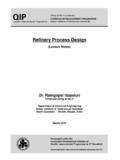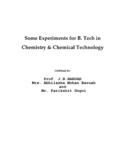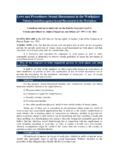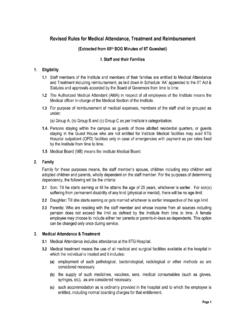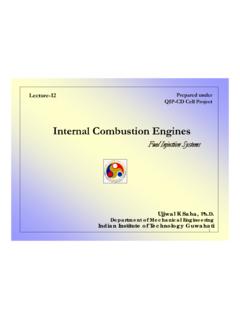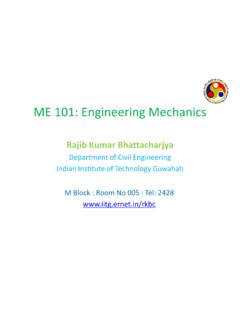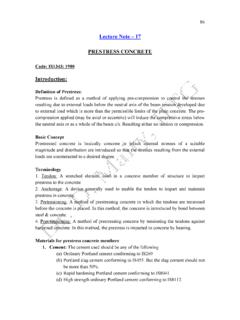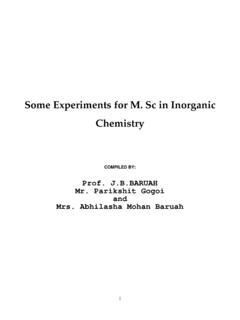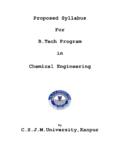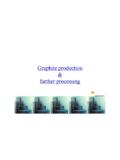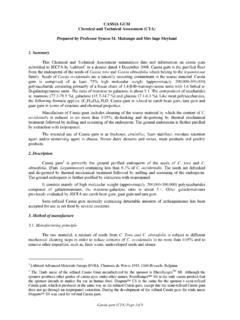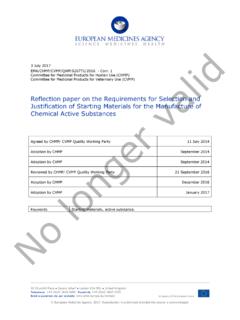Transcription of Powder metallurgy – basics & applications
1 R. Ganesh Narayanan, IITGP owder metallurgy basics & applicationsPowder metallurgy science of producing metal powders and making finished /semifinished objects from mixed or alloyed powders with or without the addition of nonmetallic constituentsSteps in Powder metallurgy : Powder production, Compaction, Sintering, & Secondary operationsPowder production:Raw materials => Powder ; Powders can be pure elements, pre%alloyed powdersMethods for making powders Atomization: Produces powders of both ferrous and non%ferrous powders like stainless steel, superalloys, Ti alloy powders; Reduction of compounds: Production of iron, Cu, tungsten, molybdenum; Electrolysis: for making Cu, iron, silver powdersPowders along with additives are mixed using mixersLubricants are added prior to mixing to facilitate easy ejection of compact and to minimize wear of tools; Waxes, metallic stearates, graphite characterization size, flow, density, compressibility testsR.
2 Ganesh Narayanan, IITGC ompaction:compaction is performed using dies machined to close tolerancesDies are made of cemented carbide, die/tool steel; pressed using hydraulic or mechanical pressesThe basic purpose of compaction is to obtain a green compact with sufficient strength to withstand further handling operationsThe green compact is then taken for sinteringHot extrusion, hot pressing, hot isostatic pressing => consolidation at high temperaturesSintering: Performed at controlled atmosphere to bond atoms metallurgically; Bonding occurs by diffusion of atoms; done at 70% of abs. melting point of materialsIt serves to consolidate the mechanically bonded powders into a coherent body having desired on service behaviorDensification occurs during the process and improvement in physical and mechanical properties are seenFurnaces mesh belt furnaces (up to 1200C), walking beam, pusher type furnace, batch type furnaces are also usedProtective atmosphere: Nitrogen (widely used)R.
3 Ganesh Narayanan, IITGS econdary operations:Operations include repressing, grinding, plating can be done; They are used to ensure close dimensional tolerances, good surface finish, increase density, corrosion resistance chart for making P/M componentsR. Ganesh Narayanan, IITGA dvantages & limitations Efficient material utilization Enables close dimensional tolerances near net shape possible Good surface finish Manufacture of complex shapes possible Hard materials used to make components that are difficult to machine can be readily made tungsten wires for incandescent lamps Environment friendly, energy efficient Suited for moderate to high volume component production Powders of uniform chemical composition => reflected in the finished part wide variety of materials => miscible, immiscible systems; refractory metals Parts with controlled porosity can be made High cost of Powder material & tooling Less strong parts than wrought ones Less well known processR.
4 Ganesh Narayanan, IITGP roduction of powders Metal powders => Main constituent of a P/M product; final properties of the finished P/M part depends on size, shape, and surface area of Powder particles Single Powder production method is not sufficient for all applicationsPowder production methods: 1. Mechanical methods, 2. Physical methods, 3. Chemical methods1. Mechanical methods=> cheapest of the Powder production methods; These methods involve using mechanical forces such as compressive forces, shear or impact to facilitate particle size reduction of bulk materials; Eg.:MillingMilling:During milling , impact, attrition, shear and compression forces are acted upon particles. During impact, striking of one Powder particle against another occurs.
5 Attritionrefers to the production of wear debris due to the rubbing action between two particles. Shearrefers to cutting of particles resulting in fracture. The particles are broken into fine particles by squeezing action in compression force objective of milling :Particle size reduction (main purpose),Particle size growth, shape change, agglomeration (joining of particles together), solid state alloying, mechanical or solid state mixing, modification of material propertiesR. Ganesh Narayanan, IITGM echanism of milling : Changes in the morphology of Powder particles during milling results in the following Microforging, 2. Fracture, 3. Agglomeration, 4. DeagglomerationMicroforging => Individual particles or group of particles are impacted repeatedly so that they flatten with very less change in massFracture => Individual particles deform and cracks initiate and propagate resulting in fractureAgglomeration => Mechanical interlocking due to atomic bonding or vande WaalsforcesDeagglomeration => Breaking of agglomeratesThe different Powder characteristics influenced by milling are shape, size, texture, particle size distribution, crystalline size, chemical composition, hardness, density, flowability, compressibility, sinterability, sintered densityMilling equipment.
6 The equipments are generally classified as crushers & millsCrushing=> for making ceramic materials such as oxides of metals; Grinding=> for reactive metals such as titanium, zirconium, niobium, tantalumR. Ganesh Narayanan, IITGG rinding:Different types of grinding equipments/methods are shown in the figureJaw crusherGyratory crusherRoll crusherBall MillVibratory Ball MillAttritorRod MillHammer MillPlanetary MillR. Ganesh Narayanan, IITGBall mills This contains cylindrical vessel rotating horizontally along the axis. Length of the cylinder is more or less equal to diameter. The vessel is charged with the grinding media. The grinding media may be made of hardened steel, or tungsten carbide, ceramics like agate, porcelain, alumina, zirconia.
7 During rolling of vessel, the grinding media & Powder particles roll from some height. This process grinds the Powder materials by impact/collision & attrition. milling can be dry milling or wet milling . In dry milling , about 25 vol% of Powder is added along with about 1 wt% of a lubricant such as stearic or oleic acid. For wet milling , 30%40 vol% of Powder with 1 wt% of dispersing agent such as water, alcohol or hexane is employed. Optimum diameter of the mill for grinding powders is about 250 mmBall MillR. Ganesh Narayanan, IITGV ibratory ball mill Finer Powder particles need longer periods for grinding In this case, vibratory ball mill is better => here high amountof energy is imparted to the particles and milling is accelerated by vibrating the container This mill contains an electric motor connected to the shaft of the drum by an elastic coupling.
8 The drum is usually lined with wear resistant material. During operation, 80% of the container is filled with grinding bodies and the starting material. Here vibratory motion is obtained by an eccentric shaft that is mounted on a frame inside the mill. The rotation of eccentric shaft causes the drum of the vibrating mill to oscillate. In general, vibration frequency is equal to 1500 to 3000 amplitude of oscillations is 2 to 3 mm. The grinding bodies is made of steel or carbide balls, that are 10%20 mm in mass of the balls is 8%10 times the charged particle size is of the order of 5%100 micronsVibratory Ball MillR. Ganesh Narayanan, IITGA ttrition mill: IN this case, the charge is ground to fine size by the action of a vertical shaft with side arms attached to it.
9 The ball to charge ratio may be 5:1, 10:1, 15:1. This method is more efficient in achieving fine particle mills:Horizontal rods are used instead of balls to grind. Granularity of the discharge material is 40%10 mm. The mill speed varies from 12 to 30 mill:High energy mill widely used for producing metal, alloy, and composite energy grinding or Jet milling :The basic principle of fluid energy mill is to induce particles to collide against each other at high velocity, causing them to fracture into fine Ganesh Narayanan, IITG Multiple collisions enhance the reduction process and therefore, multiple jet arrangements are normally incorporated in the mill design. The fluid used is either air about MPa or stream at 2 MPa. In the case of volatile materials, protective atmosphere of nitrogen and carbon%di%oxide is used.
10 The pressurized fluid is introduced into the grinding zone through specially designed nozzles which convert the applied pressure to kinetic energy. Also materials to be powdered are introduced simultaneously into the turbulent zone. The velocity of fluid coming out from the nozzles is directly proportional to the square root of the absolute temperature of the fluid entering the nozzle. Hence it is preferable to raise the temperature of fluid to the maximum possible level without affecting the feed material. If further powdering is required, large size particles are separated from the rest centrifugal forces and re%circulated into the turbulent zone for size reduction. Fine particles are taken to the exit by viscous drag of the exhaust gases to be carried away for collection.
